Stress management | Ó««Ó«®Ó«ģÓ«┤Ó»üÓ«żÓ»ŹÓ«żÓ«żÓ»ŹÓ«żÓ«┐Ó«▒Ó»ŹÓ«ĢÓ»åÓ«żÓ«┐Ó«░Ó«ŠÓ«® Ó««Ó»ćÓ«▓Ó«ŠÓ«ŻÓ»ŹÓ««Ó»łÓ«ĢÓ«│Ó»Ź | Juhin J
2 likes773 views
This content is exclusively for Bsc- Nursing Students...
1 of 12
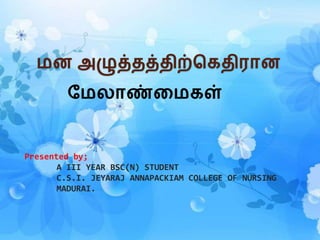


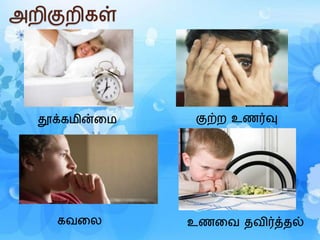
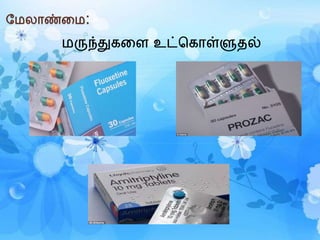


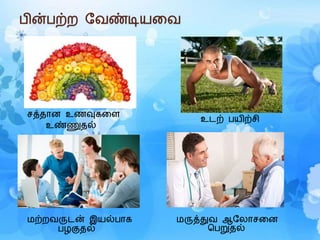
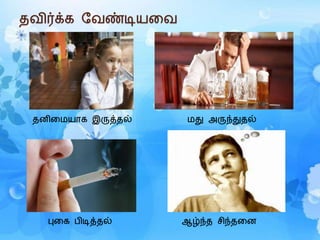

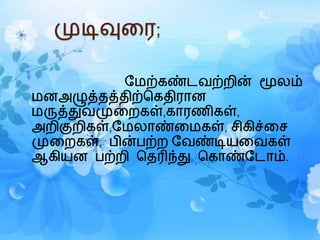

Ad
Recommended
Psychological changes of pregnancy
Psychological changes of pregnancyReynel Dan
╠²
Psychological changes during pregnancy are influenced by various social, cultural and family factors. A woman's attitudes towards her pregnancy are shaped by the environment she was raised in, messages from her family, and the society and culture she lives in. Initial reactions to pregnancy can include a wide range of emotions from surprise to fear. As the pregnancy progresses, most women reach an acceptance. Cultural beliefs and societal views of pregnancy and childbirth have changed over time and continue to influence expectations. Family background also impacts how positive or negative one views pregnancy and motherhood.Why is family planning important?
Why is family planning important?Min Zaw
╠²
This document discusses family planning and contraception. It explains why family planning is important for health, discusses when pregnancy is recommended or not recommended, and provides information about various contraceptive methods including effectiveness, continuation rates, and eligibility. The goals of family planning are to space and limit pregnancies to promote maternal and child health. Modern contraceptive methods like oral contraceptives, condoms, IUDs and implants are very effective but proper use is required for maximum effectiveness.Unwed mothers
Unwed mothersAmandeep Jhinjar
╠²
1) Unwed mothers are women who become pregnant without being legally married, which is considered a sin in traditional societies like India.
2) Causes of unwed motherhood include poverty, prostitution, teenage mistakes, lack of sex education, and contraceptive failure.
3) Unwed mothers face social stigma and rejection from their families and communities, resulting in psychological, economic, and health problems for themselves and their children who lack support.Grief & Bereavement
Grief & BereavementRAVI RAI DANGI
╠²
Grief and bereavement are difficult emotions experienced after the death of a loved one. The loss of a close family member or friend can cause intense feelings of sadness, anger, and stress as one comes to terms with their absence. It is a normal process to feel grief, and while painful, working through these emotions is an important part of healing.Worm infestation
Worm infestationcharusharma208
╠²
Worm infestation, primarily affecting children, poses significant health threats due to infections by helminths such as pinworms, roundworms, and hookworms. Symptoms can include irritability, weight loss, abdominal pain, and in severe cases, anemia or intestinal obstruction, with management involving proper hygiene, medication, and sometimes surgical intervention. Preventive measures emphasize personal hygiene, thorough washing of food, and regular deworming to mitigate infestation risks.Nurse Practitioner
Nurse PractitionerRakesh Datta
╠²
The document discusses the roles and responsibilities of community health nurse practitioners, midwifery nurse practitioners, and the conceptual foundations behind advanced practice nurses. It outlines the history and development of nurse practitioners, defining them as registered nurses who have obtained advanced education and clinical training to provide primary care, make diagnoses, and prescribe treatment plans under a specialty certification. The duties of community health and midwifery nurse practitioners are described in addition to the educational requirements, certifications, legal issues, and conceptual frameworks that guide advanced nursing practice.Self breast examination
Self breast examinationSREEVIDYA UMMADISETTI
╠²
This document provides information on breast self-examination (BSE). It recommends that women over 20 perform monthly BSE, a few days after their period if applicable. The method involves inspection of each breast while standing and lying down, using different hand positions to feel for lumps or abnormalities. Palpation techniques like circular, linear and wedge motions are used. Mammography is also discussed as a screening and diagnostic tool to detect breast cancer early through characteristic masses or microcalcifications.Lesson plan on Glomerulonephitis
Lesson plan on GlomerulonephitisSoumya Ranjan Parida
╠²
The document outlines a lesson plan on glomerulonephritis, focusing on its definition, incidence, etiology, pathophysiology, clinical manifestations, diagnostic evaluation, and management strategies. It details the teaching activities, objectives, and assessment methods, as well as nursing management and potential complications associated with the condition. The conclusion emphasizes that glomerulonephritis can vary in severity and may lead to serious outcomes like chronic kidney failure.Communication and utilisation of research findings
Communication and utilisation of research findingssudhashivakumar
╠²
This document discusses communication and utilization of research findings. It defines communication of research findings as interpreting complex results so nonexperts can understand. The purposes of communication include bridging clinical practice and research, promoting learning, and improving quality of care. Key steps outlined are selecting the audience and method, avoiding jargon, and effective writing. Common methods of communication are written reports, oral reports, and poster presentations. Barriers to research utilization include issues related to nurses, organizations, research, and communication. Strategies to facilitate use include developing research departments, education programs, and open communication.biophysical assessment of fetus
biophysical assessment of fetusSharon Treesa Antony
╠²
This document provides an overview of various biophysical tests used to assess fetal wellbeing, including fetal movement count, FHR monitoring, cardiotocography, non-stress test, contraction stress test, amniotic fluid volume assessment, ultrasound, biophysical profile, modified biophysical profile, Doppler velocimetry, CT scan, and MRI scan. It describes the procedures, interpretations, and indications for each test. Overall, the document serves as a comprehensive reference for common biophysical assessments used in antenatal care.Care of elderly
Care of elderlyRushikesh Pawar
╠²
The document discusses the aging population trends globally and in India. It notes that populations are transitioning to lower birth and death rates, resulting in more older persons than ever before. In India specifically, 10% of those over 60 suffer from mobility issues and over 50% of those over 70 have at least one chronic condition. The National Programme for Health Care of the Elderly was launched in 2010 to address the growing health needs of the elderly through community-based primary care and establishing geriatric services at various levels of the healthcare system from the community to regional centers. The program aims to promote healthy aging, prevent and manage diseases, and rehabilitate the elderly.DEVELOPMENT OF NURSING EDUCATION IN INDIA: PRE-INDEPENDENCE TO INDEPENDENCE.
DEVELOPMENT OF NURSING EDUCATION IN INDIA: PRE-INDEPENDENCE TO INDEPENDENCE.PRANATI PATRA
╠²
The document outlines the historical development of nursing education in India from pre-independence to independence, emphasizing the origins of nursing and its evolution through various cultural periods. It highlights significant milestones, including ancient medical texts, military and civilian nursing training, and the establishment of nursing associations. The conclusion stresses the importance of university education in shaping modern nursing professionals, focusing on a well-rounded personal development.Characteristics of a Healthy Newborn
Characteristics of a Healthy Newbornrittikadas7
╠²
The document describes the characteristics of a healthy newborn. It defines a healthy newborn as one born at term between 38-42 weeks, with an average birth weight over 2.5 kg that cries immediately and establishes independent respiration. It outlines the physical characteristics including average weight, length, head circumference and chest circumference. It also describes the vital signs, skin, head, face features, chest, abdomen, extremities and physiological behaviors expected in a healthy newborn. Key reflexes exhibited by newborns are also outlined.Ppt methods of acquiring knowledge
Ppt methods of acquiring knowledgejyoti dwivedi
╠²
1. The document discusses the scientific method and problem solving process in research. It defines scientific method as an objective, logical, and systematic process of experimentation used to explore observations and answer questions.
2. The six basic steps of the scientific method are outlined as asking a question, doing background research, constructing a hypothesis, testing the hypothesis through experimentation, analyzing the data and drawing a conclusion, and communicating the results.
3. Problem solving is described as a formal application of identifying problems, formulating hypotheses, making observations, analyzing data, and drawing conclusions. The six steps of the problem solving process are defining the problem, determining the root cause, developing solutions, selecting a solution, implementing the solution, andCommunity health nurse in disaster management
Community health nurse in disaster managementNursing Path
╠²
This document discusses the role of community health nurses in disaster management. It describes how there are two main types of disasters: natural disasters and man-made disasters. The objectives of disaster nursing are to reduce the impact on human life and health, participate in coordinated relief efforts, and initiate rehabilitation. Community health nurses play an important role in disaster preparedness, response, and recovery. Their duties include educating the community, assessing vulnerabilities, implementing disaster plans, and addressing both physical and mental health needs after a disaster occurs.ISSUES FOR COUNSELING IN NURSING STUDENTS.pdf
ISSUES FOR COUNSELING IN NURSING STUDENTS.pdfTARUNKUMAR431238
╠²
The document discusses various issues related to counseling for nursing students, including poor organizational setup, resistance to counseling, and lack of awareness about its necessity. It highlights challenges such as inadequate funding, low counselor-counselee ratios, and non-recognition of the counseling profession. Ethical and moral issues in counseling are also addressed, emphasizing the importance of confidentiality and the need for trained counselors.immunology-immunization schedule.pdf
immunology-immunization schedule.pdfakshyhari
╠²
Thank you for the presentation. I have learned about the importance of immunization and the national immunization schedule in India.Research in chn
Research in chnAthira Bprasad
╠²
This document defines research and discusses the need for and purposes of community health research. It outlines different methods of community health research, including descriptive and explanatory research as well as quantitative and qualitative methods. The document also lists various areas that are appropriate for research in community health nursing, such as health problems, aged care, disease distribution, effectiveness of health services, and health care practices.3 dimensional av aids.ppt
3 dimensional av aids.pptJobin Jacob
╠²
This document discusses different types of teaching aids used in education, including models, exhibits, specimens, mock-ups, moulages, objects, and dioramas. It provides definitions and examples of each type. Some key points made are that models make learning direct and meaningful by representing things three-dimensionally, exhibits combine information with pleasure and foster creativity, and using real objects and specimens can help enhance students' observation and social skills. Both benefits and limitations of each teaching aid are presented.Tips to reduce alcohol intake | Psycho Education | Juhin J
Tips to reduce alcohol intake | Psycho Education | Juhin JJuhin J
╠²
Tips to reduce alcohol intake:
- Gradually reduce the number of drinks
- Use smaller glasses
- Substitute a glass of water in between alcoholic drinks
- Change triggering environment
- Change from your preferred alcoholic drink to one you do not like
- Don't stock up on alcohol
- Be realistic
- Find healthy coping mechanismDigital Addiction | Psycho Education | Juhin J
Digital Addiction | Psycho Education | Juhin JJuhin J
╠²
Digital Addiction:
---Signs & Symptoms---
- Unable to leave your house without phone
- Compelled to check the phone constantly for no particular reason
- Eating with your phone on the table
- Feeling anxious or depressed after using social media
- Obsessed over sending or recieving a text or posting a comment
- Feeling afraid of missing out
---Management---
- Start the day without mobile phone
- Turn off devices 30 minutes before bed
- Delete time setealing apps from your phone
- Turn off notifications
- Only respond to emails and texts at specific times of the dayStress Management | Psycho Education | Juhin J
Stress Management | Psycho Education | Juhin JJuhin J
╠²
Stress Management:
- Get enough sleep (6-8 hours)
- Be active
- Engage in meditation and yoga
- Eat well
- Take a break
- Talk to someone
- Practice deep breathing
Tips to improve Sleep Quality | Psycho Education | Juhin J
Tips to improve Sleep Quality | Psycho Education | Juhin JJuhin J
╠²
Tips to improve Sleep Quality:
- Establish a regular bedtime and waking time
- Do regular exercise
- Use comfortable bed
- Make sure your bedroom is quiet, dark with good ventilation
- Switch off your electronic devices 30-60 minutes before bed
- Avoid taking heavy foods before sleep
- Reduce intake of water before bed
- Avoid coffee, alcohol & nicotine intake
Warning Signs of Mental Illness | Psycho education | Juhin J
Warning Signs of Mental Illness | Psycho education | Juhin JJuhin J
╠²
Warning Signs of Mental Illness:
- Excessive sadness & anxiety lasting more than 2 weeks
- Sleeping or eating more/less than usual
- Inability to perform daily tasks
- Harming self
- Increased use of alcohol or other substances
- Unusual mood changes
- Decreased performance
- Believing things that aren't real
Rights of Special Groups | Constitution of Indian | Juhin J
Rights of Special Groups | Constitution of Indian | Juhin JJuhin J
╠²
The document outlines the rights of various special groups, including children, women, HIV/AIDS patients, the handicapped, the aged, and the mentally ill. It details fundamental rights as defined by the Constitution of India, focusing on legal entitlements and protections against discrimination and exploitation. Additionally, it identifies barriers to accessing these rights, such as poverty and social inequality.Continuing Nursing Education- CNE | Nursing Education | Juhin J
Continuing Nursing Education- CNE | Nursing Education | Juhin JJuhin J
╠²
The document outlines the objectives and definitions of Continuing Nursing Education (CNE), emphasizing its importance for the personal and professional growth of nurses. It covers features, functions, principles, and various types of CNE, including formal, informal, experiential, and self-directed learning. Additionally, it highlights the role of CNE in developing competent nurse practitioners and enhancing nursing practice through updated knowledge and skills.Socioeconomic Status Scale | Nursing Education | Juhin J
Socioeconomic Status Scale | Nursing Education | Juhin JJuhin J
╠²
The document provides an overview of socioeconomic status (SES), its definition, scale, and its influence on health outcomes. It details various SES classification scales, including Prasad, Udai Pareek, Kuppuswamy, and others, highlighting their methodologies, advantages, and limitations. Additionally, it discusses the importance of understanding poverty lines and the impact of socioeconomic factors on health and well-being.Alternative Systems of Medicine in Mental Health | AYUSH | CAM | Juhin J
Alternative Systems of Medicine in Mental Health | AYUSH | CAM | Juhin JJuhin J
╠²
The document provides a comprehensive overview of alternative medicine systems in mental health, including classification, principles, and specific therapies such as herbal medicine, unani, siddha, homeopathy, acupuncture, and acupressure. It emphasizes the interconnectedness of mind, body, and spirit in healing, and discusses the role of nurses in integrating these alternative approaches into patient care. Limitations and potential side effects of these therapies are also highlighted, along with the necessity for nurses to be knowledgeable in order to guide patients appropriately.Disorders of Thought and Perception | Mental Health & Psychiatric Nursing | J...
Disorders of Thought and Perception | Mental Health & Psychiatric Nursing | J...Juhin J
╠²
The document outlines disorders of thought and perception, focusing on defining and classifying thought and perception disorders. Thought disorders lead to disorganized thinking and abnormal expression, while perception disorders affect the understanding of sensory data. It includes classifications for both types of disorders and lists references for further reading.Impulse Control Disorder | Psychiatric Nursing | Juhin J
Impulse Control Disorder | Psychiatric Nursing | Juhin JJuhin J
╠²
The document provides a comprehensive overview of impulse control disorders, including definitions, classifications, epidemiology, and treatment options for conditions such as intermittent explosive disorder, kleptomania, pyromania, and trichotillomania. Each disorder is discussed in terms of its clinical manifestations, diagnostic criteria, etiology, course, and management strategies. The document also highlights the nursing process for addressing ineffective coping and impulse control, emphasizing therapeutic interventions.More Related Content
What's hot (11)
Communication and utilisation of research findings
Communication and utilisation of research findingssudhashivakumar
╠²
This document discusses communication and utilization of research findings. It defines communication of research findings as interpreting complex results so nonexperts can understand. The purposes of communication include bridging clinical practice and research, promoting learning, and improving quality of care. Key steps outlined are selecting the audience and method, avoiding jargon, and effective writing. Common methods of communication are written reports, oral reports, and poster presentations. Barriers to research utilization include issues related to nurses, organizations, research, and communication. Strategies to facilitate use include developing research departments, education programs, and open communication.biophysical assessment of fetus
biophysical assessment of fetusSharon Treesa Antony
╠²
This document provides an overview of various biophysical tests used to assess fetal wellbeing, including fetal movement count, FHR monitoring, cardiotocography, non-stress test, contraction stress test, amniotic fluid volume assessment, ultrasound, biophysical profile, modified biophysical profile, Doppler velocimetry, CT scan, and MRI scan. It describes the procedures, interpretations, and indications for each test. Overall, the document serves as a comprehensive reference for common biophysical assessments used in antenatal care.Care of elderly
Care of elderlyRushikesh Pawar
╠²
The document discusses the aging population trends globally and in India. It notes that populations are transitioning to lower birth and death rates, resulting in more older persons than ever before. In India specifically, 10% of those over 60 suffer from mobility issues and over 50% of those over 70 have at least one chronic condition. The National Programme for Health Care of the Elderly was launched in 2010 to address the growing health needs of the elderly through community-based primary care and establishing geriatric services at various levels of the healthcare system from the community to regional centers. The program aims to promote healthy aging, prevent and manage diseases, and rehabilitate the elderly.DEVELOPMENT OF NURSING EDUCATION IN INDIA: PRE-INDEPENDENCE TO INDEPENDENCE.
DEVELOPMENT OF NURSING EDUCATION IN INDIA: PRE-INDEPENDENCE TO INDEPENDENCE.PRANATI PATRA
╠²
The document outlines the historical development of nursing education in India from pre-independence to independence, emphasizing the origins of nursing and its evolution through various cultural periods. It highlights significant milestones, including ancient medical texts, military and civilian nursing training, and the establishment of nursing associations. The conclusion stresses the importance of university education in shaping modern nursing professionals, focusing on a well-rounded personal development.Characteristics of a Healthy Newborn
Characteristics of a Healthy Newbornrittikadas7
╠²
The document describes the characteristics of a healthy newborn. It defines a healthy newborn as one born at term between 38-42 weeks, with an average birth weight over 2.5 kg that cries immediately and establishes independent respiration. It outlines the physical characteristics including average weight, length, head circumference and chest circumference. It also describes the vital signs, skin, head, face features, chest, abdomen, extremities and physiological behaviors expected in a healthy newborn. Key reflexes exhibited by newborns are also outlined.Ppt methods of acquiring knowledge
Ppt methods of acquiring knowledgejyoti dwivedi
╠²
1. The document discusses the scientific method and problem solving process in research. It defines scientific method as an objective, logical, and systematic process of experimentation used to explore observations and answer questions.
2. The six basic steps of the scientific method are outlined as asking a question, doing background research, constructing a hypothesis, testing the hypothesis through experimentation, analyzing the data and drawing a conclusion, and communicating the results.
3. Problem solving is described as a formal application of identifying problems, formulating hypotheses, making observations, analyzing data, and drawing conclusions. The six steps of the problem solving process are defining the problem, determining the root cause, developing solutions, selecting a solution, implementing the solution, andCommunity health nurse in disaster management
Community health nurse in disaster managementNursing Path
╠²
This document discusses the role of community health nurses in disaster management. It describes how there are two main types of disasters: natural disasters and man-made disasters. The objectives of disaster nursing are to reduce the impact on human life and health, participate in coordinated relief efforts, and initiate rehabilitation. Community health nurses play an important role in disaster preparedness, response, and recovery. Their duties include educating the community, assessing vulnerabilities, implementing disaster plans, and addressing both physical and mental health needs after a disaster occurs.ISSUES FOR COUNSELING IN NURSING STUDENTS.pdf
ISSUES FOR COUNSELING IN NURSING STUDENTS.pdfTARUNKUMAR431238
╠²
The document discusses various issues related to counseling for nursing students, including poor organizational setup, resistance to counseling, and lack of awareness about its necessity. It highlights challenges such as inadequate funding, low counselor-counselee ratios, and non-recognition of the counseling profession. Ethical and moral issues in counseling are also addressed, emphasizing the importance of confidentiality and the need for trained counselors.immunology-immunization schedule.pdf
immunology-immunization schedule.pdfakshyhari
╠²
Thank you for the presentation. I have learned about the importance of immunization and the national immunization schedule in India.Research in chn
Research in chnAthira Bprasad
╠²
This document defines research and discusses the need for and purposes of community health research. It outlines different methods of community health research, including descriptive and explanatory research as well as quantitative and qualitative methods. The document also lists various areas that are appropriate for research in community health nursing, such as health problems, aged care, disease distribution, effectiveness of health services, and health care practices.3 dimensional av aids.ppt
3 dimensional av aids.pptJobin Jacob
╠²
This document discusses different types of teaching aids used in education, including models, exhibits, specimens, mock-ups, moulages, objects, and dioramas. It provides definitions and examples of each type. Some key points made are that models make learning direct and meaningful by representing things three-dimensionally, exhibits combine information with pleasure and foster creativity, and using real objects and specimens can help enhance students' observation and social skills. Both benefits and limitations of each teaching aid are presented.More from Juhin J (20)
Tips to reduce alcohol intake | Psycho Education | Juhin J
Tips to reduce alcohol intake | Psycho Education | Juhin JJuhin J
╠²
Tips to reduce alcohol intake:
- Gradually reduce the number of drinks
- Use smaller glasses
- Substitute a glass of water in between alcoholic drinks
- Change triggering environment
- Change from your preferred alcoholic drink to one you do not like
- Don't stock up on alcohol
- Be realistic
- Find healthy coping mechanismDigital Addiction | Psycho Education | Juhin J
Digital Addiction | Psycho Education | Juhin JJuhin J
╠²
Digital Addiction:
---Signs & Symptoms---
- Unable to leave your house without phone
- Compelled to check the phone constantly for no particular reason
- Eating with your phone on the table
- Feeling anxious or depressed after using social media
- Obsessed over sending or recieving a text or posting a comment
- Feeling afraid of missing out
---Management---
- Start the day without mobile phone
- Turn off devices 30 minutes before bed
- Delete time setealing apps from your phone
- Turn off notifications
- Only respond to emails and texts at specific times of the dayStress Management | Psycho Education | Juhin J
Stress Management | Psycho Education | Juhin JJuhin J
╠²
Stress Management:
- Get enough sleep (6-8 hours)
- Be active
- Engage in meditation and yoga
- Eat well
- Take a break
- Talk to someone
- Practice deep breathing
Tips to improve Sleep Quality | Psycho Education | Juhin J
Tips to improve Sleep Quality | Psycho Education | Juhin JJuhin J
╠²
Tips to improve Sleep Quality:
- Establish a regular bedtime and waking time
- Do regular exercise
- Use comfortable bed
- Make sure your bedroom is quiet, dark with good ventilation
- Switch off your electronic devices 30-60 minutes before bed
- Avoid taking heavy foods before sleep
- Reduce intake of water before bed
- Avoid coffee, alcohol & nicotine intake
Warning Signs of Mental Illness | Psycho education | Juhin J
Warning Signs of Mental Illness | Psycho education | Juhin JJuhin J
╠²
Warning Signs of Mental Illness:
- Excessive sadness & anxiety lasting more than 2 weeks
- Sleeping or eating more/less than usual
- Inability to perform daily tasks
- Harming self
- Increased use of alcohol or other substances
- Unusual mood changes
- Decreased performance
- Believing things that aren't real
Rights of Special Groups | Constitution of Indian | Juhin J
Rights of Special Groups | Constitution of Indian | Juhin JJuhin J
╠²
The document outlines the rights of various special groups, including children, women, HIV/AIDS patients, the handicapped, the aged, and the mentally ill. It details fundamental rights as defined by the Constitution of India, focusing on legal entitlements and protections against discrimination and exploitation. Additionally, it identifies barriers to accessing these rights, such as poverty and social inequality.Continuing Nursing Education- CNE | Nursing Education | Juhin J
Continuing Nursing Education- CNE | Nursing Education | Juhin JJuhin J
╠²
The document outlines the objectives and definitions of Continuing Nursing Education (CNE), emphasizing its importance for the personal and professional growth of nurses. It covers features, functions, principles, and various types of CNE, including formal, informal, experiential, and self-directed learning. Additionally, it highlights the role of CNE in developing competent nurse practitioners and enhancing nursing practice through updated knowledge and skills.Socioeconomic Status Scale | Nursing Education | Juhin J
Socioeconomic Status Scale | Nursing Education | Juhin JJuhin J
╠²
The document provides an overview of socioeconomic status (SES), its definition, scale, and its influence on health outcomes. It details various SES classification scales, including Prasad, Udai Pareek, Kuppuswamy, and others, highlighting their methodologies, advantages, and limitations. Additionally, it discusses the importance of understanding poverty lines and the impact of socioeconomic factors on health and well-being.Alternative Systems of Medicine in Mental Health | AYUSH | CAM | Juhin J
Alternative Systems of Medicine in Mental Health | AYUSH | CAM | Juhin JJuhin J
╠²
The document provides a comprehensive overview of alternative medicine systems in mental health, including classification, principles, and specific therapies such as herbal medicine, unani, siddha, homeopathy, acupuncture, and acupressure. It emphasizes the interconnectedness of mind, body, and spirit in healing, and discusses the role of nurses in integrating these alternative approaches into patient care. Limitations and potential side effects of these therapies are also highlighted, along with the necessity for nurses to be knowledgeable in order to guide patients appropriately.Disorders of Thought and Perception | Mental Health & Psychiatric Nursing | J...
Disorders of Thought and Perception | Mental Health & Psychiatric Nursing | J...Juhin J
╠²
The document outlines disorders of thought and perception, focusing on defining and classifying thought and perception disorders. Thought disorders lead to disorganized thinking and abnormal expression, while perception disorders affect the understanding of sensory data. It includes classifications for both types of disorders and lists references for further reading.Impulse Control Disorder | Psychiatric Nursing | Juhin J
Impulse Control Disorder | Psychiatric Nursing | Juhin JJuhin J
╠²
The document provides a comprehensive overview of impulse control disorders, including definitions, classifications, epidemiology, and treatment options for conditions such as intermittent explosive disorder, kleptomania, pyromania, and trichotillomania. Each disorder is discussed in terms of its clinical manifestations, diagnostic criteria, etiology, course, and management strategies. The document also highlights the nursing process for addressing ineffective coping and impulse control, emphasizing therapeutic interventions.Personality Disorders | Psychiatric Nursing | Juhin J
Personality Disorders | Psychiatric Nursing | Juhin JJuhin J
╠²
The document outlines the definitions, epidemiology, etiology, risk factors, classification, clinical manifestations, diagnostic evaluations, and management of personality disorders. It emphasizes the complexity of personality traits and the varied approaches needed for effective treatment, including both pharmacological and non-pharmacological methods. Additionally, it discusses nursing management strategies for supporting patients with personality disorders.Histrionic, Narcissistic & Avoidance Personality Disorder | Psychiatric Nursi...
Histrionic, Narcissistic & Avoidance Personality Disorder | Psychiatric Nursi...Juhin J
╠²
The document discusses personality and personality disorders, focusing on histrionic, narcissistic, and avoidant personality disorders, including their definitions, risk factors, classifications, and management strategies. It provides insights into the clinical manifestations, epidemiology, comorbidities, and nursing management related to these disorders. Additionally, it includes results from studies on job fit and the influence of narcissism on sexual coercion among young adult women.SLEEP DISORDERS | Psychiatric Nursing | Juhin J
SLEEP DISORDERS | Psychiatric Nursing | Juhin JJuhin J
╠²
The document provides an overview of sleep, including its definitions, processes, stages, functions, and disorders. It outlines the epidemiology of sleep disorders in the Indian population and classifies sleep disorders into categories such as primary sleep disorders, psychiatric-related disorders, and substance-induced disorders. Additionally, it discusses nursing processes and interventions for managing sleep disorders.Personality Disorders | Psychiatric Nursing | Juhin J
Personality Disorders | Psychiatric Nursing | Juhin JJuhin J
╠²
The document discusses personality disorders, defining them as enduring patterns of behavior and inner experience that deviate from cultural norms. It covers key topics such as epidemiology, etiology, risk factors, classification, clinical manifestations, diagnostic evaluation, and management strategies, including both pharmacological and non-pharmacological approaches. Additionally, it outlines nursing management techniques for addressing the diverse needs of patients with personality disorders.Obsessive Compulsive Disorder | Psychiatric Nursing | Juhin J
Obsessive Compulsive Disorder | Psychiatric Nursing | Juhin J Juhin J
╠²
This document outlines the essential aspects of Obsessive-Compulsive Disorder (OCD), including its definition, epidemiology, clinical features, and management strategies. It highlights the chronic nature of OCD, its impact on individuals, and the various treatment options available, both pharmacological and non-pharmacological. The document also discusses relevant studies that explore the relationship between OCD and other disorders, as well as the influence of family dynamics on patient experiences.Hallucinogen Use Disorder | Substance Abuse | Psychiatric Nursing | Juhin J
Hallucinogen Use Disorder | Substance Abuse | Psychiatric Nursing | Juhin JJuhin J
╠²
Hallucinogen use disorder involves substances that distort reality and induce hallucinations, historically used in ceremonies for over 7,000 years. The document discusses various hallucinogens, their usage patterns, physiological and psychological effects, and treatment guidelines, including nursing management strategies and preventive measures. In India, 0.12% of the population reported hallucinogen use, highlighting the importance of education and targeted interventions to address substance abuse.Opioid Use Disorder | Substance Abuse | Psychiatric Nursing | Juhin J
Opioid Use Disorder | Substance Abuse | Psychiatric Nursing | Juhin JJuhin J
╠²
The document provides an overview of opioid use disorder, its historical context, substance profiles, patterns of use, and management strategies. It highlights the prevalence of opioid use in India, the effects of opioids on the body, symptoms of intoxication and withdrawal, and outlines treatment approaches including pharmacotherapy and psychosocial support. Additionally, it emphasizes the importance of prevention, rehabilitation, and the need for a multi-disciplinary approach in managing opioid-related issues.Inhalant Use Disorder | Substance Abuse | Psychiatric Nursing | Juhin J
Inhalant Use Disorder | Substance Abuse | Psychiatric Nursing | Juhin JJuhin J
╠²
Inhalant use disorder arises from inhaling substances like fuels and solvents, leading to euphoria and impaired judgment, primarily affecting youths aged 12-17. As of 2019, around 0.70% of Indians aged 10-75 use inhalants, with a significant need for treatment, particularly in states like Uttar Pradesh. Treatment includes managing symptoms and promoting abstinence, with prevention strategies focused on education and socio-economic improvements.Delirium & Delirum Tremens | Psychiatric Nursing | Juhin J
Delirium & Delirum Tremens | Psychiatric Nursing | Juhin JJuhin J
╠²
The document provides a comprehensive overview of delirium, including its definition, incidence, prevalence, etiology, clinical manifestations, and management strategies. Delirium is characterized by a rapid disturbance of consciousness and cognition, commonly affecting elderly patients and hospital inpatients. Additionally, it covers delirium tremens, a severe condition related to alcohol withdrawal, detailing its causes, symptoms, and treatment options.Ad
Stress management | Ó««Ó«®Ó«ģÓ«┤Ó»üÓ«żÓ»ŹÓ«żÓ«żÓ»ŹÓ«żÓ«┐Ó«▒Ó»ŹÓ«ĢÓ»åÓ«żÓ«┐Ó«░Ó«ŠÓ«® Ó««Ó»ćÓ«▓Ó«ŠÓ«ŻÓ»ŹÓ««Ó»łÓ«ĢÓ«│Ó»Ź | Juhin J
- 1. Ó««Ó«® Ó«ģÓ«┤Ó»üÓ«żÓ»ŹÓ«żÓ«żÓ»ŹÓ«żÓ«┐Ó«▒Ó»ŹÓ«ĢÓ»åÓ«żÓ«┐Ó«░Ó«ŠÓ«® Presented by; A III YEAR BSC(N) STUDENT C.S.I. JEYARAJ ANNAPACKIAM COLLEGE OF NURSING MADURAI. Ó««Ó««Ó«▓Ó«ŠÓ«ŻÓ»ŹÓ««Ó««Ó»åÓ«│Ó»Ź
- 2. Ó««Ó»üÓ«®Ó»ŹÓ«®Ó»üÓ«░Ó»ł Ó««Ó«®Ó«ģÓ«┤Ó»üÓ«żÓ»ŹÓ«żÓ«żÓ»ŹÓ«żÓ«┐Ó«▒Ó»ŹÓ«ĢÓ»ŹÓ«ĢÓ»åÓ«żÓ«┐Ó»łÓ«ŠÓ«® Ó««Ó««Ó«▓Ó«ŠÓ«ŻÓ»ŹÓ«░Ó««Ó»åÓ«│Ó«┐Ó«▓Ó»Ź Ó««Ó«░Ó»üÓ«©Ó»ŹÓ«żÓ»üÓ»åÓ«│Ó»Ź Ó«ģÓ«żÓ«┐Ó»åÓ««Ó»Ź Ó«¬Ó«»Ó«®Ó»ŹÓ«¬Ó«¤Ó»üÓ«żÓ»ŹÓ«ż Ó«¬Ó«¤Ó»üÓ»åÓ«┐Ó«®Ó»ŹÓ«▒Ó«®. Ó«ģÓ«░Ó»ł Ó««Ó«® Ó«ģÓ«┤Ó»üÓ«żÓ»ŹÓ«żÓ«żÓ»ŹÓ«░Ó«ż Ó««Ó«¬Ó«ŠÓ«ĢÓ»ŹÓ»åÓ«┐ Ó««Ó«®Ó«┐Ó«żÓ«®Ó»üÓ«ĢÓ»ŹÓ«ĢÓ»ü Ó«¬Ó»üÓ«żÓ»ŹÓ«żÓ»üÓ«ŻÓ«░Ó»ŹÓ«ÜÓ»ŹÓ«ÜÓ«┐ Ó«ĢÓ«¬Ó«▒ Ó«ēÓ«żÓ«ĄÓ»üÓ»åÓ«┐Ó«®Ó»ŹÓ«▒Ó«®. Ó««Ó««Ó«▓Ó»üÓ««Ó»Ź Ó«ģÓ«░Ó»ł Ó««Ó«®Ó«┐Ó«żÓ«®Ó»üÓ«░Ó»łÓ«» Ó«ÜÓ«┐Ó«©Ó»ŹÓ«żÓ«░Ó«® Ó««Ó«▒Ó»ŹÓ«▒Ó»üÓ««Ó»Ź Ó«ĢÓ«ÜÓ«»Ó«▓Ó»ŹÓ«¬Ó«¤Ó»üÓ««Ó»Ź Ó«żÓ«┐Ó«▒Ó«®Ó«┐Ó«▓Ó»Ź Ó««Ó«ŠÓ«▒Ó»ŹÓ«▒Ó«żÓ»ŹÓ«░Ó«ż Ó«ÅÓ«▒Ó»ŹÓ«¬Ó«¤Ó»üÓ«żÓ»ŹÓ«żÓ«┐ Ó««Ó«® Ó«ģÓ«┤Ó»üÓ«żÓ»ŹÓ«żÓ«żÓ»ŹÓ«░Ó«ż Ó«©Ó»ĆÓ«ĢÓ»ŹÓ«ĢÓ»üÓ»åÓ«┐Ó«▒Ó«żÓ»ü.
- 3. Ó»åÓ«ŠÓ»łÓ«ŻÓ«┐Ó»åÓ«│Ó»Ź Ó«ēÓ«»Ó«┐Ó«░Ó»Ź Ó««Ó»łÓ«żÓ«┐Ó««Ó«ŠÓ«▒Ó»ŹÓ«▒Ó«ÖÓ»ŹÓ»åÓ«│Ó»Ź Ó«ĢÓ«¬Ó«▒Ó»ŹÓ««Ó«▒Ó«ŠÓ«░Ó»ŹÓ»åÓ«│Ó«┐Ó«®Ó»Ź Ó«ćÓ«▒Ó«¬Ó»ŹÓ«¬Ó»ü Ó««Ó«¬Ó«ŠÓ«░Ó«ż Ó«ĢÓ«¬Ó«ŠÓ«░Ó»üÓ«¤Ó»ŹÓ»åÓ«│Ó»Ź Ó«ĢÓ«¬Ó«▒Ó»ŹÓ««Ó«▒Ó«ŠÓ«░Ó»Ź Ó«¬Ó»üÓ«▒Ó«ĢÓ»ŹÓ»åÓ«ŻÓ«┐Ó«żÓ»ŹÓ«żÓ«▓Ó»Ź
- 6. Ó«żÓ«┐Ó«░Ó«Ü Ó«żÓ«┐Ó«░Ó»üÓ«¬Ó»ŹÓ«¬Ó»üÓ««Ó»Ź Ó«ÜÓ«┐Ó»åÓ«┐Ó«ÜÓ»ŹÓ«░Ó«Ü Ó«żÓ«┐Ó«»Ó«ŠÓ«®Ó««Ó»Ź Ó«ĢÓ«ÜÓ«»Ó»ŹÓ«żÓ«▓Ó»Ź Ó«¬Ó»üÓ«żÓ»ŹÓ«żÓ»åÓ««Ó»Ź Ó»łÓ«ŠÓ«ÜÓ«┐Ó«żÓ»ŹÓ«żÓ«▓Ó»Ź Ó«¬Ó«ŠÓ»łÓ«▓Ó»Ź Ó««Ó»åÓ«¤Ó»ŹÓ»łÓ«▓Ó»Ź Ó«ĢÓ«żÓ«ŠÓ«░Ó«▓ Ó»åÓ«ŠÓ«¤Ó»ŹÓ«ÜÓ«┐ Ó«¬Ó«ŠÓ«░Ó»ŹÓ«¬Ó»ŹÓ«¬Ó«żÓ»ü
- 7. Ó«ĢÓ«żÓ«ŠÓ«┤Ó«┐Ó«▓Ó»Ź Ó««Ó»üÓ«░Ó«▒ Ó«ÜÓ«┐Ó»åÓ«┐Ó«ÜÓ»ŹÓ«░Ó«Ü Ó«░Ó»å Ó»łÓ«┐Ó«░Ó«® Ó«ĢÓ«¬Ó«ŠÓ«░Ó»üÓ«¤Ó»ŹÓ»åÓ«│Ó»Ź Ó«ĢÓ«ÜÓ«»Ó»ŹÓ«» Ó«¬Ó«┤Ó«ĢÓ»ŹÓ«ĢÓ»üÓ»łÓ«┐Ó«żÓ»ŹÓ«żÓ«▓Ó»Ź
- 8. Ó«¬Ó«┐Ó«®Ó»ŹÓ«¬Ó«▒Ó»ŹÓ«▒ Ó««Ó»łÓ«ŻÓ»ŹÓ«¤Ó«┐Ó«»Ó«░Ó»ł Ó«ÜÓ«żÓ»ŹÓ«żÓ«ŠÓ«® Ó«ēÓ«ŻÓ«ĄÓ»üÓ»åÓ«░Ó«│ Ó«ēÓ»łÓ«▒Ó»Ź Ó«¬Ó«»Ó«┐Ó«▒Ó»ŹÓ«ÜÓ«┐ Ó««Ó«▒Ó»ŹÓ«▒Ó»łÓ«░Ó»üÓ»łÓ«®Ó»Ź Ó«ćÓ«»Ó«▓Ó»ŹÓ«¬Ó«ŠÓ»å Ó«¬Ó«┤Ó«ĢÓ»üÓ«żÓ«▓Ó»Ź Ó«ēÓ«ŻÓ»ŹÓ«ŻÓ»üÓ«żÓ«▓Ó»Ź Ó««Ó«░Ó»üÓ«żÓ»ŹÓ«żÓ»üÓ»ł Ó«åÓ««Ó«▓Ó«ŠÓ«ÜÓ«░Ó«® Ó«ĢÓ«¬Ó«▒Ó»üÓ«żÓ«▓Ó»Ź
- 9. Ó«żÓ»łÓ«┐Ó«░Ó»ŹÓ«ĢÓ»ŹÓ»å Ó««Ó»łÓ«ŻÓ»ŹÓ«¤Ó«┐Ó«»Ó«░Ó»ł Ó«żÓ«®Ó«┐Ó«░Ó««Ó«»Ó«ŠÓ»å Ó«ćÓ«░Ó»üÓ«żÓ»ŹÓ«żÓ«▓Ó»Ź Ó««Ó«żÓ»ü Ó«ģÓ«░Ó»üÓ«©Ó»ŹÓ«żÓ»üÓ«żÓ«▓Ó»Ź Ó«åÓ«┤Ó»ŹÓ«©Ó»ŹÓ«ż Ó«ÜÓ«┐Ó«©Ó»ŹÓ«żÓ«░Ó«®Ó«¬Ó»üÓ«░Ó»å Ó«¬Ó«┐Ó«¤Ó«┐Ó«żÓ»ŹÓ«żÓ«▓Ó»Ź
- 10. Ó«¬Ó«ĢÓ»ŹÓ»å Ó»łÓ«┐Ó«░Ó«│Ó«ĄÓ»üÓ»åÓ«│Ó»Ź Ó»łÓ«▒Ó«ŻÓ»ŹÓ»ł Ó«©Ó«ŠÓ«ĄÓ»ü Ó««Ó«ÜÓ«ŠÓ«░Ó»ŹÓ«ĄÓ»ü Ó«żÓ«░Ó«▓ Ó»łÓ«▓Ó«┐ Ó«ĢÓ»üÓ«░Ó«▒Ó«©Ó»ŹÓ«ż Ó»łÓ«żÓ»ŹÓ«żÓ«ģÓ«┤Ó»üÓ«żÓ»ŹÓ«żÓ««Ó»Ź
- 11. Ó««Ó»üÓ«¤Ó«┐Ó«ĄÓ»üÓ«░Ó»ł; Ó««Ó««Ó«▒Ó»ŹÓ»åÓ«ŻÓ»ŹÓ»łÓ»łÓ«▒Ó»ŹÓ«▒Ó«┐Ó«®Ó»Ź Ó««Ó»éÓ«▓Ó««Ó»Ź Ó««Ó«®Ó«ģÓ«┤Ó»üÓ«żÓ»ŹÓ«żÓ«żÓ»ŹÓ«żÓ«┐Ó«▒Ó»ŹÓ«ĢÓ»åÓ«żÓ«┐Ó»łÓ«ŠÓ«® Ó««Ó«░Ó»üÓ«żÓ»ŹÓ«żÓ»üÓ»łÓ««Ó»üÓ«░Ó«▒Ó»åÓ«│Ó»Ź,Ó»åÓ«ŠÓ»łÓ«ŻÓ«┐Ó»åÓ«│Ó»Ź, Ó«ģÓ«▒Ó«┐Ó«ĢÓ»üÓ«▒Ó«┐Ó»åÓ«│Ó»Ź,Ó««Ó««Ó«▓Ó«ŠÓ«ŻÓ»ŹÓ«░Ó««Ó»åÓ«│Ó»Ź, Ó«ÜÓ«┐Ó»åÓ«┐Ó«ÜÓ»ŹÓ«░Ó«Ü Ó««Ó»üÓ«░Ó«▒Ó»åÓ«│Ó»Ź, Ó«¬Ó«┐Ó«®Ó»ŹÓ«¬Ó«▒Ó»ŹÓ«▒ Ó««Ó»łÓ«ŻÓ»ŹÓ«¤Ó«┐Ó«»Ó«░Ó»łÓ»åÓ«│Ó»Ź Ó«åÓ»åÓ«┐Ó«»Ó«® Ó«¬Ó«▒Ó»ŹÓ«▒Ó«┐ Ó«ĢÓ«żÓ«░Ó«┐Ó«©Ó»ŹÓ«żÓ»ü Ó«ĢÓ»åÓ«ŠÓ«ŻÓ»ŹÓ««Ó»łÓ«ŠÓ««Ó»Ź.
